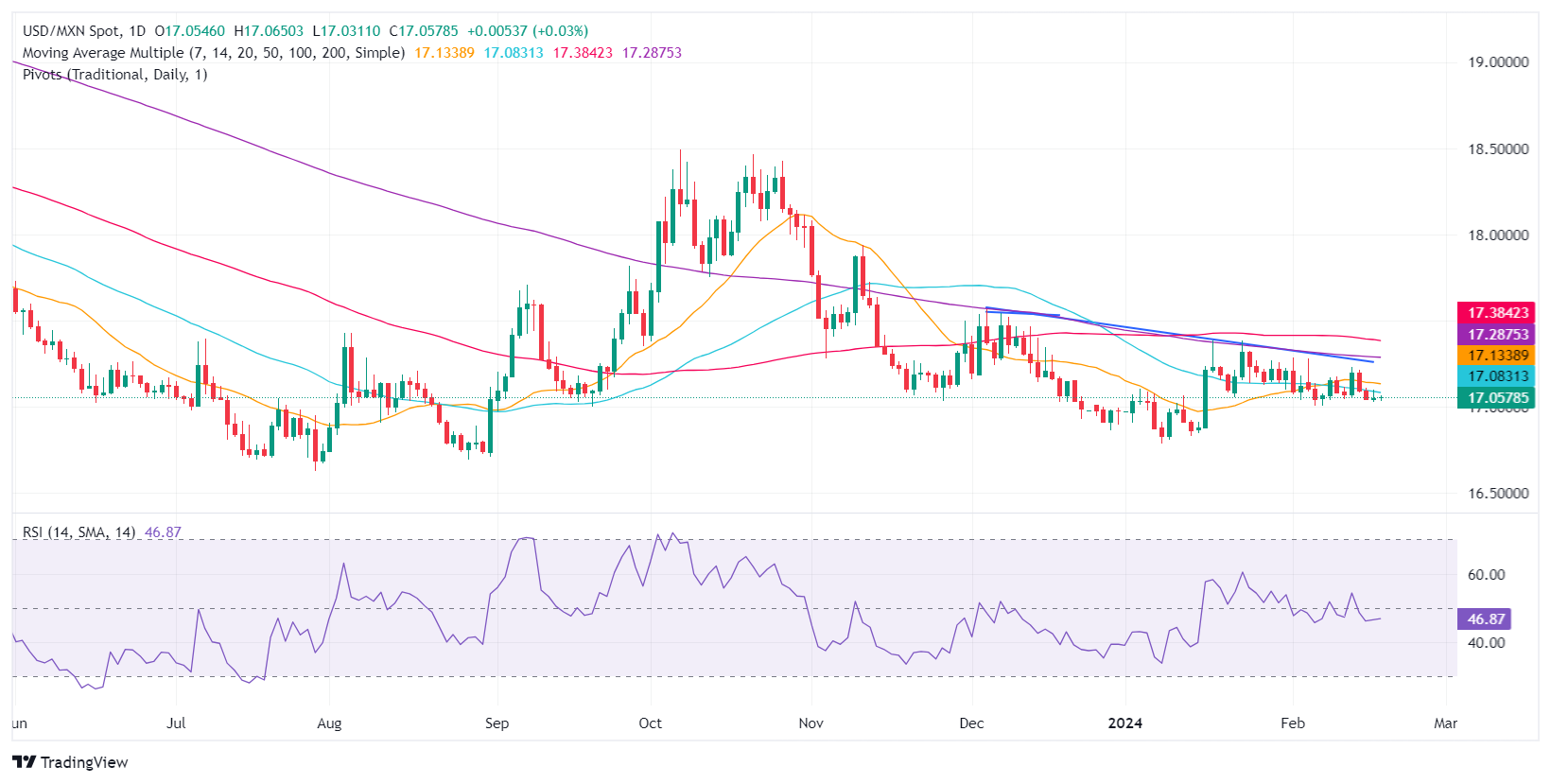Mexican Peso stays firm against US Dollar amid thin trading conditions

- Mexican Peso remains steady as low trading volume marks US Presidents’ Day.
- Mexico’s IOAE indicates a -0.7% MoM contraction with a modest 1.3% annual growth in early 2024.
- US-Mexico trade disputes over steel and aluminum exports could impact the Peso’s future stability.
The Mexican Peso seesaws against the US Dollar on Monday as low volume trading is due to the United States observing Presidents’ Day. The Indicator of Economic Activity (IOAE), which provides preliminary readings on a monthly basis, suggests the Mexican economy most likely contracted in January 2024. The USD/MXN trades at 17.05, almost flat, at the time of writing.
Mexico’s National Statistics Agency (INEGI) revealed the IOAE contracted -0.7% MoM. In annual comparison, the economy most likely grew by 1.3% at the beginning of 2024. Late in the week, Mexico’s economic schedule will feature Retail Sales, the Gross Domestic Product (GDP) for Q4 2023 and the mid-month inflation report in February.
The USD/MXN remains weak, accumulating losses of 0.59% in year-to-date (YTD) figures. Nevertheless, pressure from the US regarding Mexico’s exports of steel and aluminum, along with implicit risks of the general election, threaten to derail the Mexican currency.
US trade representative Katherine Tai warned Mexico that the US could reimpose tariffs on imports of the aforementioned commodities if the Mexican Government, led by Andres Manuel Lopez Obrador (AMLO), fails to take urgent measures to stop the increase in exports. US authorities question Mexico’s lack of transparency on imports of steel and aluminum from third countries.
Daily digest market movers: Mexican Peso unchanged as trading liquidity drains on US holiday
- Mexico’s economic schedule will feature Retail Sales on February 21, expected to rise 0.2% MoM in December and 2.5% YoY.
- On February 22, the Mexican economy is projected to have grown 0.1% in Q4 2023 and 2.4% YoY. Mid-month underlying inflation for February is estimated to slow from 4.78% to 4.67 YoY, while is projected to drop from 4.9% to 4.7%.
- Across the border, the US economic docket will feature the release of the latest Federal Reserve Open Market Committee (FOMC) Minutes alongside Fed officials crossing the wires.
- Traders will get further cues from US S&P Global PMIs, Initial Jobless Claims data and the Chicago Fed National Activity Index, usually a prelude of the Institute for Supply Management (ISM) Manufacturing PMI.
- Last Friday, prices paid by producers exceeded forecasts, which means the Personal Consumption Expenditures (PCE), the Fed’s preferred gauge for inflation, could aim higher in February.
- Consumer sentiment in the US improved slightly to 79.5 from 79.0 in January’s last reading, according to the University of Michigan Survey. Analysts foresaw an improvement to 80.0 on its preliminary reading.
- Inflation expectations in the US remained steady, with one-year inflation at 3%, up from 2.9%, while for a five-year period it stood unchanged at 2.9%.
- Fed’s Bostic said patience is required and he foresees two rate cuts, which could begin in the summer if the data justifies it. Fed’s Daly said, “We will need to resist the temptation to act quickly when patience is needed and be prepared to respond agilely as the economy evolves.”
- Market players are expecting the first rate cut by the Federal Reserve at the June monetary policy meeting as they have trimmed odds for March and May.
Technical analysis: Mexican Peso is virtually unchanged as USD/MXN hovers circa 17.05
The USD/MXN seesaws near the 17.05 mark, below the 50-day Simple Moving Average (SMA) at 17.09. Even though that favors further downside, sellers must drag the exchange rate below the 17.00 figure if they would like to remain hopeful of challenging last year’s low of 16.62.
Otherwise, if buyers reclaim the 50-day SMA, followed by the latest cycle high of 17.22, that will expose the 200-day SMA at 17.29. A decisive break and the USD/MXN could rally toward the 100-day SMA at 17.39, followed by the 17.50 area. Buyers will eye a re-test of the 18.00 mark.
USD/MXN Price Action – Daily Chart
Banxico FAQs
The Bank of Mexico, also known as Banxico, is the country’s central bank. Its mission is to preserve the value of Mexico’s currency, the Mexican Peso (MXN), and to set the monetary policy. To this end, its main objective is to maintain low and stable inflation within target levels – at or close to its target of 3%, the midpoint in a tolerance band of between 2% and 4%.
The main tool of the Banxico to guide monetary policy is by setting interest rates. When inflation is above target, the bank will attempt to tame it by raising rates, making it more expensive for households and businesses to borrow money and thus cooling the economy. Higher interest rates are generally positive for the Mexican Peso (MXN) as they lead to higher yields, making the country a more attractive place for investors. On the contrary, lower interest rates tend to weaken MXN. The rate differential with the USD, or how the Banxico is expected to set interest rates compared with the US Federal Reserve (Fed), is a key factor.
Banxico meets eight times a year, and its monetary policy is greatly influenced by decisions of the US Federal Reserve (Fed). Therefore, the central bank’s decision-making committee usually gathers a week after the Fed. In doing so, Banxico reacts and sometimes anticipates monetary policy measures set by the Federal Reserve. For example, after the Covid-19 pandemic, before the Fed raised rates, Banxico did it first in an attempt to diminish the chances of a substantial depreciation of the Mexican Peso (MXN) and to prevent capital outflows that could destabilize the country.
